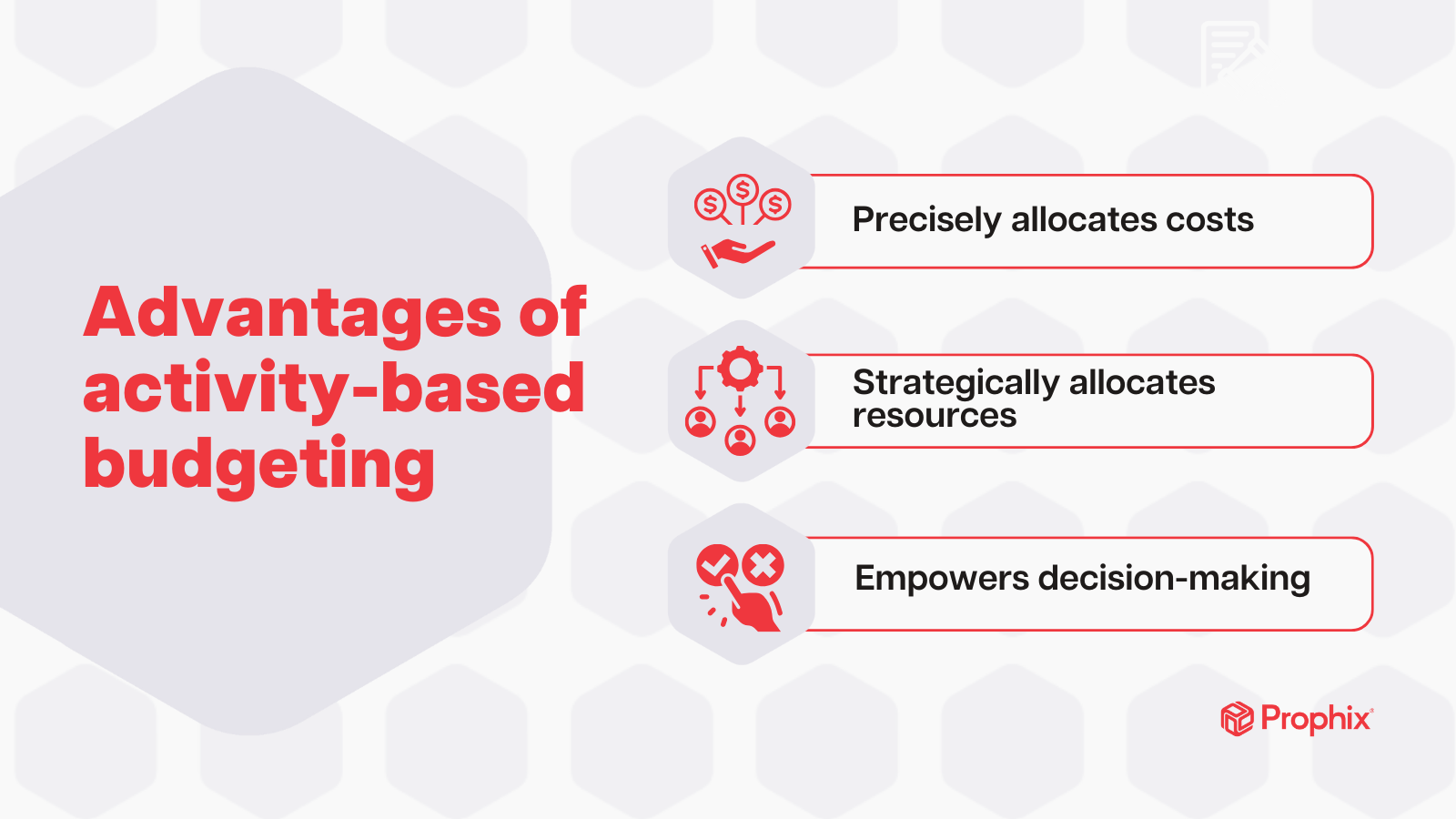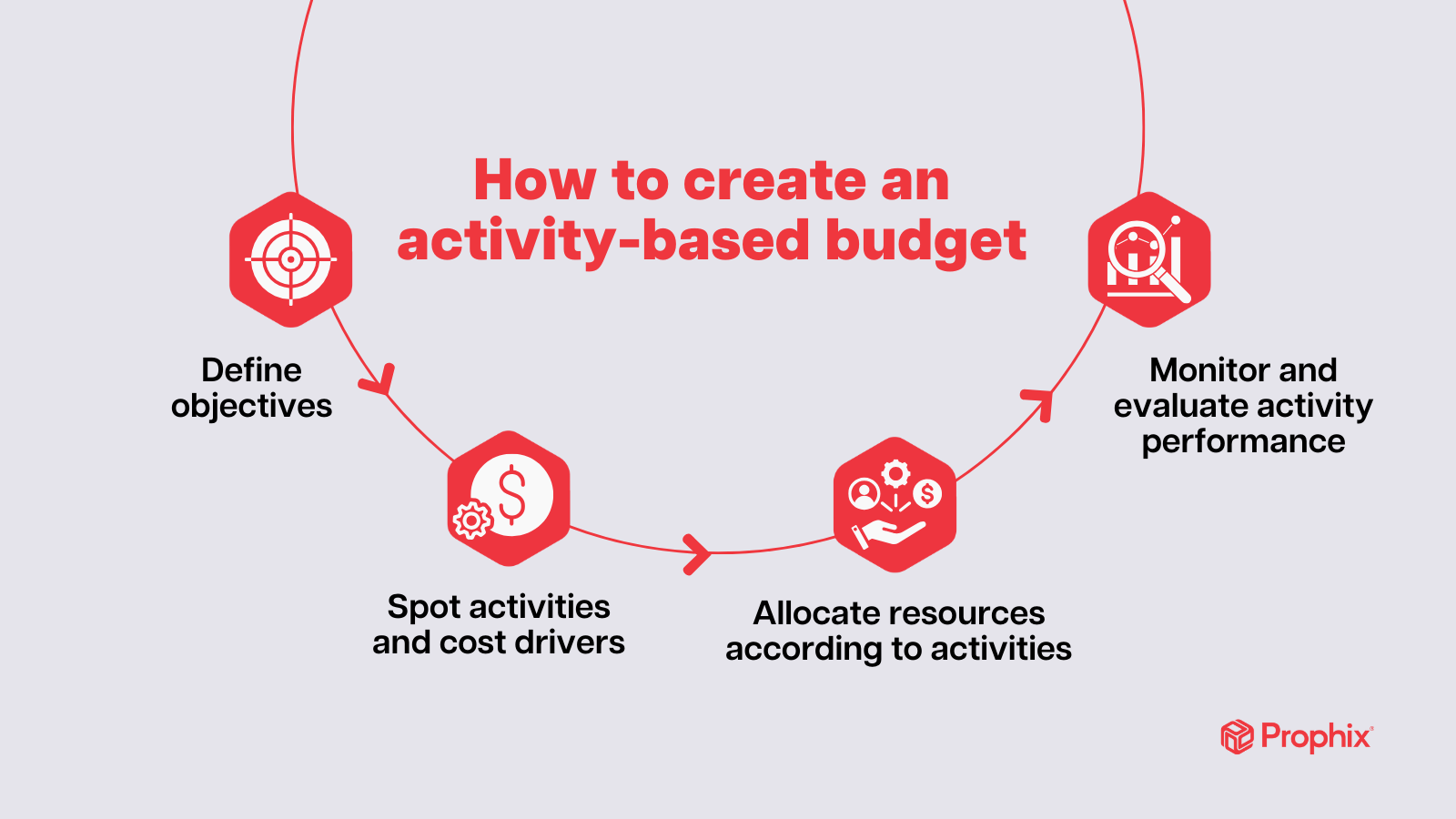What is activity-based budgeting (ABB)?
Activity-based budgeting is an essential tool for today's finance teams. It highlights the importance of focusing on value-driven activities, making efficient decisions, and aligning resources where they matter most.
By enabling cross-department collaboration and setting clear targets, activity-based budgeting effectively bridges strategic planning and operations.
In this article, we’ll cover the basics of activity-based budgeting, so you can support your organization’s goals, including:
- Wat is budgetteren in het bedrijfsleven?
- What is activity-based budgeting?
- Advantages of activity-based budgeting
- Disadvantages of activity-based budgeting
- How is activity-based budgeting different from other budgeting methods?
- What are the key elements of activity-based budgeting?
- How to conduct activity-based budgeting
- Activity-based budgeting example
- Conclusion: Activity-based budgeting with Prophix
Wat is budgetteren in het bedrijfsleven?
Budgeting in business provides a financial roadmap that outlines the allocation of resources, costs, and revenues associated with various tasks and activities. It's a blend of macro and micro perspectives, giving an overview of the company's financial health as well as details on operational activities.
Why is budgeting necessary for businesses?
Budgeting serves as a compass for businesses, steering key decision-making processes. It allows companies to allocate resources efficiently, set clear objectives, monitor performance, and facilitate better financial decisions. It's a strategic tool that helps in navigating the complex world of finance.
What are the major types of budgeting?
Several budgeting techniques exist, each with its unique approach. These include zero-based budgeting, incremental budgeting, top-down budgeting, and bottom-up budgeting. Each method offers a different perspective on resource allocation and cost management, helping businesses understand their market and activities better.
What is activity-based budgeting (ABB)?
Activity-based budgeting (ABB) identifies and allots resources based on activities required to realize the company's goals. It offers a granular perspective of costs, homing in on what truly matters - activities.
Why is activity-based budgeting useful?
Activity-based budgeting provides a granular view of the resources and costs tied to specific activities. This visibility helps businesses better allocate resources and pinpoint cost drivers to make data-driven decisions.
Who should do activity-based budgeting?
All businesses, especially those with complex activities or those seeking to fine-tune cost management and resource allocation, benefit from activity-based budgeting.
Is activity-based budgeting a top-down or bottom-up budgeting method?
Activity-based budgeting combines both top-down and bottom-up data, including insights from senior leadership on high-level goals and objectives, and details on specific activities and resource requirements from department managers.
Advantages of activity-based budgeting
Activity-based budgeting brings several benefits to the table:
Activity-based budgeting precisely allocates costs
By categorizing costs based on specific activities, activity-based budgeting allows for more accurate cost allocation, which helps businesses understand where resources are consumed and how to effectively manage expenses.
Instead of applying a blanket approach to budgeting, which can obscure the true cost of operations, activity-based budgeting ensures that each dollar spent is accounted for and linked to a specific, value-adding activity.
Activity-based budgeting strategically allocates resources
Strategic resource allocation is another advantage of activity-based budgeting, enabling businesses to prioritize activities that align with their strategic goals. This approach ensures that resources are directed towards value-adding activities, optimizing the impact of each financial decision.
Activity-based budgeting empowers decision-making
Activity-based budgeting empowers finance leaders by providing detailed insights into the impact of everyday operations and strategic initiatives. By identifying the true cost of each activity, managers can make informed decisions about where to cut costs without sacrificing value or where to invest more to foster growth.

Disadvantages of activity-based budgeting
Despite its advantages, activity-based budgeting isn't without some challenges.
Activity-based budgeting requires significant time for implementation
Implementing activity-based budgeting requires a lot of time and effort, particularly in the initial stages. This is due to the need to analyze and categorize all activities within the business and accurately assign costs to each, which can take away resources from other areas of the business, potentially slowing down projects or processes during the transition period.
Activity-based budgeting can be complex to understand
The complexity of activity-based budgeting, particularly in terms of understanding and implementation, can be a barrier to adoption. Activity-based budgeting can be complex because detailed analysis is required to accurately allocate costs to various activities. Consequently, smaller organizations or those lacking a dedicated finance team may find it challenging to fully leverage the benefits of this budgeting approach.
Activity-based budgeting might illicit resistance to change
Employees might not like the idea of switching to activity-based budgeting because they’re used to the way things have always been done. To deal with this, it's important to explain everything clearly, show how it will help in the long run, and offer some training to make the change easier.
How is activity-based budgeting different from other budgeting methods?
Activity-based budgeting sets itself apart from other budgeting methods in several crucial aspects.
Activity-based budgeting vs. the traditional budgeting process
Traditional budgeting often takes a historical approach, adjusting previous years' budgets based on expected financial outcomes for the coming year, which may result inefficiencies.
In contrast, activity-based budgeting starts each year with a clean slate, analyzing current operations, and resources needed to achieve business goals without prior budget constraints. This forward-looking approach allows companies to adapt more to changing market conditions and internal strategic shifts. It focuses on funding activities that drive value, rather than simply adjusting past expenses, promoting efficiency and strategic alignment.
Activity-based budgeting vs. zero-based budgeting
Zero-based budgeting, like activity-based budgeting, requires that every expense be justified for each new period, starting from a "zero base." However, while zero-based budgeting focuses on justifying each cost as if it were new, regardless of past spending, activity-based budgeting emphasizes understanding the cost drivers behind activities.
This key difference makes activity-based budgeting more about optimizing operations based on the activities that contribute most to strategic goals, rather than simply evaluating expenses from the past year. As a result, activity-based budgeting provides deeper insight into the cost-benefit aspects of business activities.
Activity-based budgeting vs. incremental budgeting
Incremental budgeting essentially takes last year's budget and adjusts it based on anticipated changes in the upcoming year, usually by increasing or decreasing the budget by a certain percentage. This method is often criticized for its lack of innovation and tendency to perpetuate past inefficiencies.
Unlike activity-based or zero-based budgeting, incremental budgeting does not demand a thorough examination of activities or costs, which can lead to a misallocation of resources. Therefore, incremental budgeting may not align closely with strategic objectives, potentially undermining an organization's ability to respond to changing market dynamics.
Activity-based budgeting vs. value-based budgeting
Value-based budgeting aims to allocate resources based on the value to the organization, focusing on outcomes and results rather than just activities or costs. It aligns spending with the company's core values and strategic objectives, prioritizing investments that deliver the most significant return.
While activity-based budgeting centers on the cost and efficiency of business activities, value-based budgeting extends this consideration to how these activities contribute to the organization's overarching values and priorities. This approach encourages a deeper alignment between budgetary decisions and long-term strategic direction, ensuring that every dollar spent advances the company's mission.
What are the key elements of activity-based budgeting?
Essential elements that make up activity-based budgeting include:
Identify activities and cost drivers
Identifying activities and their cost drivers provides a detailed understanding of where resources are being used within the organization. This step enables businesses to allocate budget towards activities that are the most efficient and closely aligned with achieving company goals.
Allocate resources based on activities
Allocating resources based on activities allows for a more targeted approach to budgeting, focusing on areas that directly contribute to value creation and strategic objectives. It ensures financial resources are optimized, supporting the most critical operations.
Monitor and evaluate activity performance
Monitoring and evaluating activity performance is fundamental in activity-based budgeting. This approach not only tracks the efficiency and effectiveness of each activity but also offers insight into areas for improvement. This ongoing assessment ensures that the budget remains aligned with strategic goals and can be adjusted proactively in response to changing internal or external circumstances.
How to conduct activity-based budgeting
Create an effective activity-based budget by following these steps:
- Define objectives - Establish clear goals and targets to guide the project or process effectively.
- Spot activities and cost drivers - Identify key tasks and factors influencing project costs to streamline resource allocation.
- Allocate resources according to activities - Distribute resources efficiently based on identified tasks and requirements to optimize performance.
- Monitor and evaluate activity performance - Continuously assess task execution and outcomes to ensure alignment with objectives and make necessary adjustments.

Activity-based budgeting example
Let's look at the case of Copenhagen Business School (CBS), one of Europe's largest business-focused universities. They were finding it hard to manage salary and project budgeting.
CBS had problems getting the latest data from their general ledger, which slowed down their budgeting process. The lack of a formal workflow made it even harder to create specific budgets like project, salary, or operational budgets.
CBS was looking for a tool that could work seamlessly with their accounting system and help them budget for salaries, projects, and operations - which make up about 70% of their yearly spending.
This is where Prophix comes in.
Prophix has transformed budgeting for CBS. They now use Prophix’s Financial Performance Platform for activity-based budgeting and costing, and for creating rolling forecasts every quarter. The Office of Finance can directly access student tuition figures and generate forecasts whenever they need, thanks to an integration with their ERP, Microsoft Dynamics NAV.
This has saved CBS a tremendous amount of time, freeing staff to conduct valuable data analysis. By establishing a single source of truth, CBS's Office of Finance has automated their business processes.
That’s the power of activity-based budgeting with Prophix. It provides clear, up-to-date financial data, simplifies budgeting, and saves time, enabling businesses like Copenhagen Business School to focus on what matters most.
Conclusion: Activity-based budgeting with Prophix
Activity-based budgeting can transform your organization when used effectively. With a granular understanding of costs, improved resource allocation, and enhanced decision-making capabilities, you can lead your business into the future.
Want to see how activity-based budgeting measures up to other approaches? Read top-down budgeting explained.
